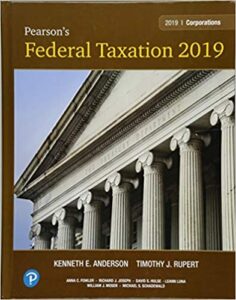Description
Test Bank For Pearson’s Federal Taxation 2019 Corporations Partnerships Estates & Trusts 32nd Edition
Overview of Corporate Liquidations
1) Liquidation and dissolution have the same legal meaning.
Answer: FALSE
Page Ref.: C:6-4
Objective: 1
2) In a complete liquidation of a corporation, which of the following is false?
A) All stock of the liquidating corporation is canceled or redeemed.
B) The corporation ceases to be a going concern.
C) The corporation divests itself of substantially all its properties.
D) The liquidation of a corporation means it has undergone dissolution.
Answer: D
Page Ref.: C:6-3 and C:6-4
Objective: 1
3) When a corporation liquidates, it performs three activities. What is the general order of these activities in a plan of liquidation?
A) pay debts, distribute property to shareholders, and wind up its affairs
B) wind up its affairs, distribute property to shareholders, pay debts
C) pay debts, wind up its affairs, and distribute property to shareholders
D) wind up its affairs, pay debts, and distribute property to shareholders
Answer: D
Page Ref.: C:6-4
Objective: 1
4) Moya Corporation adopted a plan of liquidation last year. All but a nominal amount of Moya’s assets are distributed to its shareholders within the year. Which of the following statements is not true?
A) The liquidation of Moya Corporation means the corporation has undergone dissolution.
B) Moya Corporation retains its state charter.
C) Moya Corporation’s existence is preserved.
D) Moya Corporation has been liquidated for tax purposes.
Answer: A
Page Ref.: C:6-4
Objective: 1
5) Are liquidation and dissolution the same? Explain your answer.
Answer: Liquidation status continues from the time the plan of liquidation has been formally or informally adopted until the corporation ceases to be a going concern or until it has divested itself of all its property. Dissolution is a legal term that implies that the corporation has surrendered the charter it originally received from the state. A corporation generally may complete its liquidation prior to undergoing dissolution. Dissolution may never occur if the corporation retains its charter to protect its corporate name from being acquired by another party.
Page Ref.: C:6-3 and C:6-4
Objective: 1
6) Bluebird Corporation owns and operates busses and has decided to liquidate its operations. Victor, who owns 80% of the company’s stock, will receive all of the busses, repair parts inventory, and all tools and equipment. He plans to start a bus company in another town. Penny, who owns 20% of the stock, wants nothing to do with the new bus business and will receive a cash distribution. Bluebird will incur about $20,000 of expenses in connection with the liquidation. What tax issues should Victor, Penny, and Bluebird consider with respect to the liquidation?
Answer: Penny and Victor should consider the following tax issues:
• What gains or losses does Bluebird recognize on the two distributions?
• Does Bluebird have to file a corporate tax return for the portion of the final tax year that it is in existence? If so, what income and expenses are included in the return?
• Can Bluebird deduct the liquidation expenses on its final tax return?
• What are the amounts and characters of the gain or loss that Penny and Victor recognize upon surrendering their Bluebird stock?
• What basis does Victor take for the noncash assets that he receives?
• What happens to Bluebird’s tax attributes?
Bluebird Corporation will need to recognize any gain realized on the distribution of the Bluebird busses, support vehicles, repair parts inventory, tools, and equipment. Bluebird recognizes no loss on the disposition of these items because they are distributed to a related party (Victor owns 80% of Bluebird). Penny recognizes no gain on the distribution because she receives only cash. Victor and Penny will need to determine their realized and recognized gains on the liquidation. Bluebird Corporation can deduct the liquidation expenses in its final tax return. Any NOLs incurred in the final year can be carried back to the two preceding tax years. A substantial cost may be incurred in liquidating the corporation. Perhaps Victor should consider buying Penny’s stock and keep operating Bluebird Corporation in the new city. This way the liquidation tax (e.g., on corporate and shareholder-level gains) will be avoided.
Page Ref.: C:6-2 through C:6-9, C:6-16, C:6-17
Objective: 1

Reviews
There are no reviews yet.